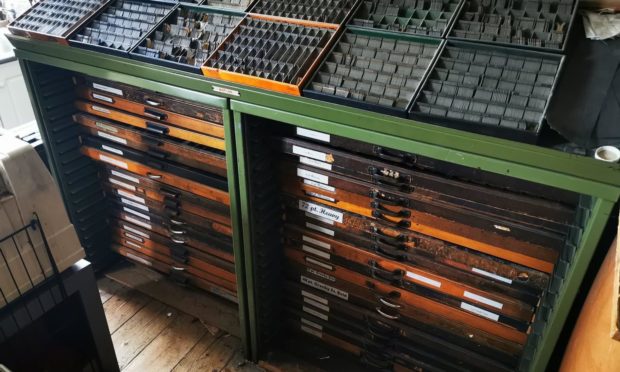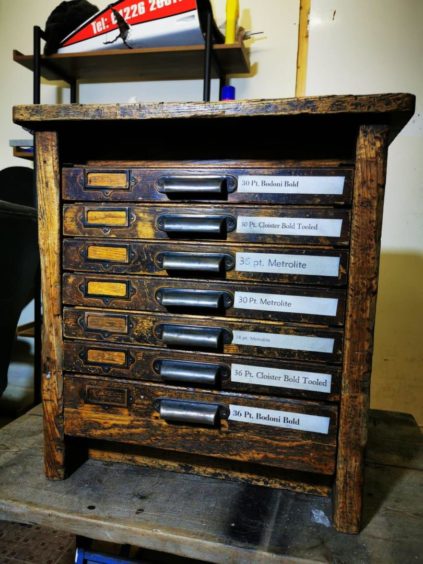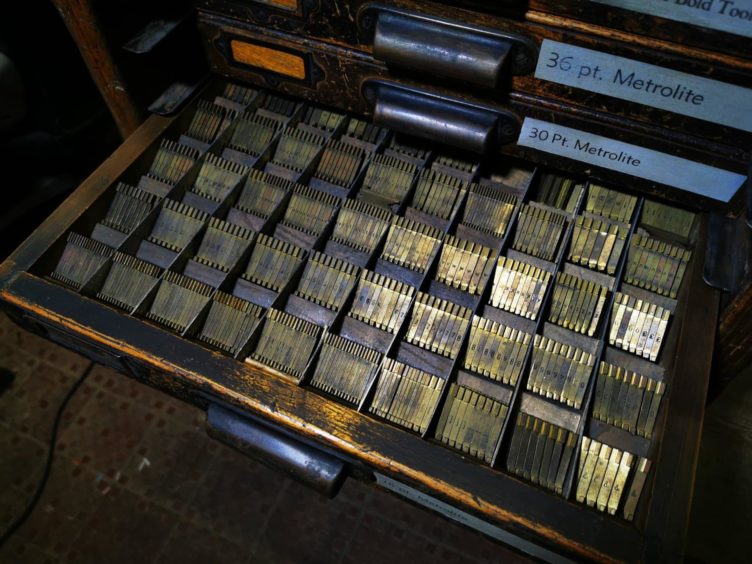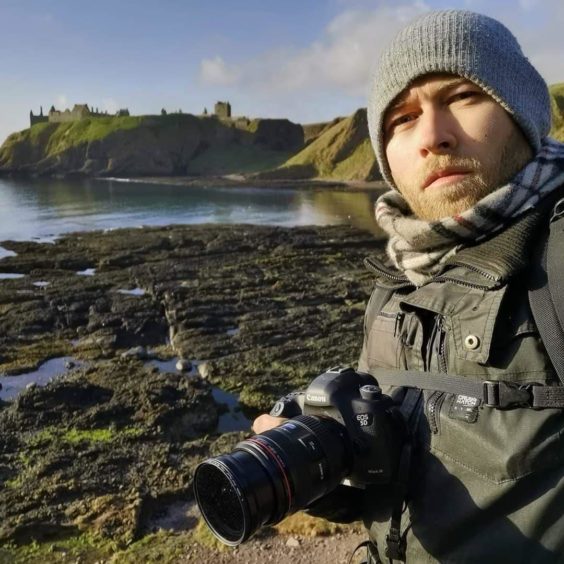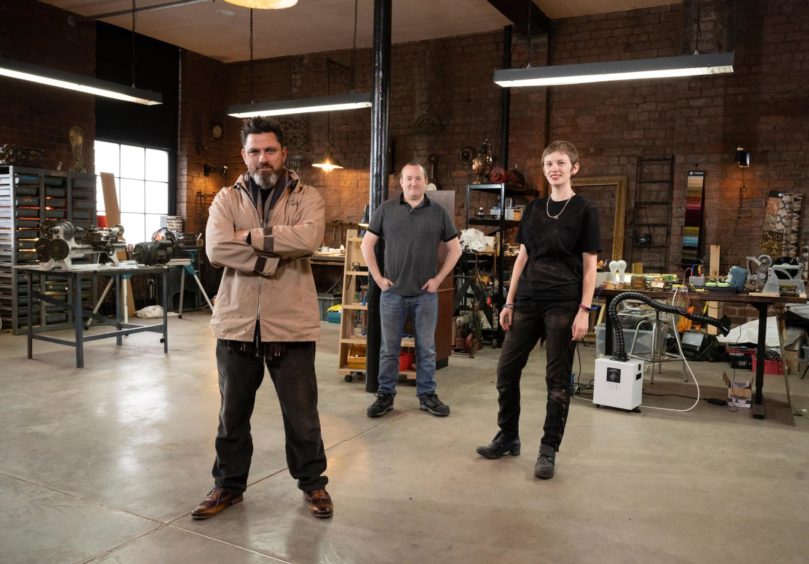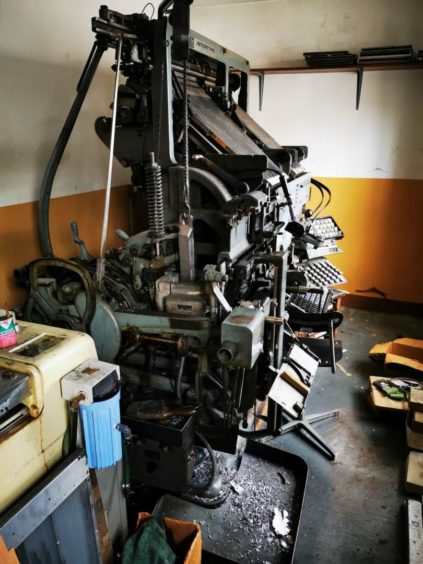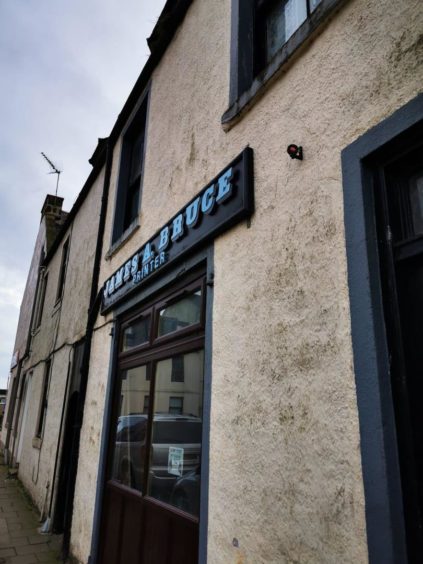A battered vintage printer’s cabinet and its original brass typefaces – once used to print thousands of copies of The Courier – has been lovingly restored in a new Channel 4 show.
The transformation of the piece of kit, which for decades saw daily service in a Stonehaven printers’ workshop, is the star of tonight’s Mend It For Money, a new series which blends Dragon’s Den with The Repair Shop.
Both Jimmy Bruce, the printer who used it for more than 30 years, and Murray Aitken, the Stonehaven upscaler who salvaged it, are delighted to see the old workhorse given a new lease of life in the show, narrated by comedy star Tom Allen.
The fascinating item – which Murray bought more than a year ago – started life with The Courier, said Jimmy, who retired in 2019 at the age of 84, having run James A Bruce Printers on Cameron Street for 55 years.
“It was when they changed over to a new computerised system, I stripped their Intertype (typesetting machine) down there and rebuilt it in Cameron Street,” he said. “That cabinet contained mattresses, the brass letters that were used for making moulds to cast the lead letters for type.
Jimmy had a passion for his job
“They were the letters used in headlines and things like that. It was just about 10 years old when I bought it 30 or so years ago, but those letters will have printed a fair few thousand copies of The Courier.”
Murray, who recently started in business recycling and upscaling unusual items as bespoke furniture and artwork, said he had been looking for a couple of printers’ trays to turn into display cases and visited Jimmy’s shop.
“It was pure chance I caught him on the right day, he was standing in the window holding two printers’ trays, which was exactly what I wanted. Jimmy and his son were in there clearing the place out,” said Murray, who is also a photographer.
“I found it quite a privilege to get a hold of these items which I knew would be very sought after, so I offered him some money which was better than him throwing them in the bin and bought a lot of his stock.
“And Jimmy is an absolutely brilliant man. He’s a great character and you can tell the passion he had for his job. I visited his premises three or four times and he would give me a tour and show me what that thing was and what he used this for.”
Among the printers’ trays, old stamps and printers’ blocks was the vintage cabinet and its brass letters in a range of fonts.
Tool that’s been worked with
“It had a fair bit of wear and tear to it, so I gave it a good clean and a light sanding to try to preserve the look of it. I didn’t want to make it look brand new or take away from the charm of it. It had some good wear, it had received a couple of knocks. It has not been a cherished piece, it’s been a tool that has been worked with. Over the years it has built up this beautiful, worn, appealing patina.”
Murray said he kept hold of the case for a while as he “loved it so much” then decided to sell it on as he originally planned and put it up for sale online – when it was spotted by one of the Mend It For Money researchers.
“Initially I rejected them because I didn’t think it needed fully restored as that might ruin some of the charm. But after a bit of consideration I thought as long as the restorers understand that and that it doesn’t need to look like a brand new piece, I would go with it.”
Murray said the whole experience of filming Mend It For Money in Glasgow last year, under Covid distancing restrictions, was fascinating. He made a pitch to two professional restorers. He then had to choose which one to go with, based on how much they thought the item would fetch at auction and how much of a cut they would take.
Broke it down and cleaned it up
He decided to go with restorer Nick Zammeti.
“He agreed with me it didn’t need too much work. He said he could maybe get £700 or £800 plus and he would take 25% of it, but I bartered it down to 20% because he said it didn’t need much work done on it,” said Murray.
Nick has a YouTube channel with more than 750,000 subscribers and for Murray that was a deciding factor in reaching a widespread audience and hopefully securing a good price.
Murray said: “Nick broke it all down, cleaned everything up and went along with the tedious task of polishing all the individual brass lettering. I was pleased.”
However, the item didn’t actually find a buyer at the end of the day and is still available on eBay, said Murray.
Murray said he was very much looking forward to watching the show.
“I enjoyed the whole experience, it’s not often you get the chance to appear on a Channel 4 show and I thought it would be a chance to kick start my name and in the local community people might take notice of what I’m doing.”
Jimmy was also looking forward to seeing his old piece of equipment in the national spotlight.
Printer to royalty
He said he used the cabinet every day over the years as he met the printing needs of Stonehaven and the wider community in what was the oldest independent business in the town.
“It saw a fair bit of use, but it was just a case of sliding out the drawers and taking the letters from it, then casting them in the machine and putting them back.”
“I was doing everything and anything,” said Jimmy. “I was doing letterheads, newsletters, compliment slips, business printing and magazines for the churches and so on. Anything that needed printing in Stonehaven, I would do it.”
Considered an antique now, his now-famous case and its fonts offer a fascinating insight into the history of printing – and even the origin of referring to letters as being upper case or lower case.
Jimmy said: “Originally there were type cases and the upper case held all the capitals and figures.”
Jimmy loved his time as a printer and had some memorable jobs in his time… including printing for royalty.
Dwindling demand in digital age
“I did some stuff for The Queen when she was at Balmoral Castle, through trade work with a firm in Aberdeen. It was invitations and letterheads and so on for The Queen. Although the vintage case wasn’t used for that,” he said.
One of the bedrocks of Jimmy’s business was printing fish tallies – the slips that identify companies and boats for boxes of fish sold at auction – for markets from Shetland to Cornwall as well as Northern Ireland.
Jimmy said he eventually decided to retire as the digital age saw demand for his services dwindle.
“With everything on computer, people were doing letterheads and things like that for themselves, so I got out while it was good,” he said.
Mend It For Money is now available on All 4, the on-demand service from Channel 4.
